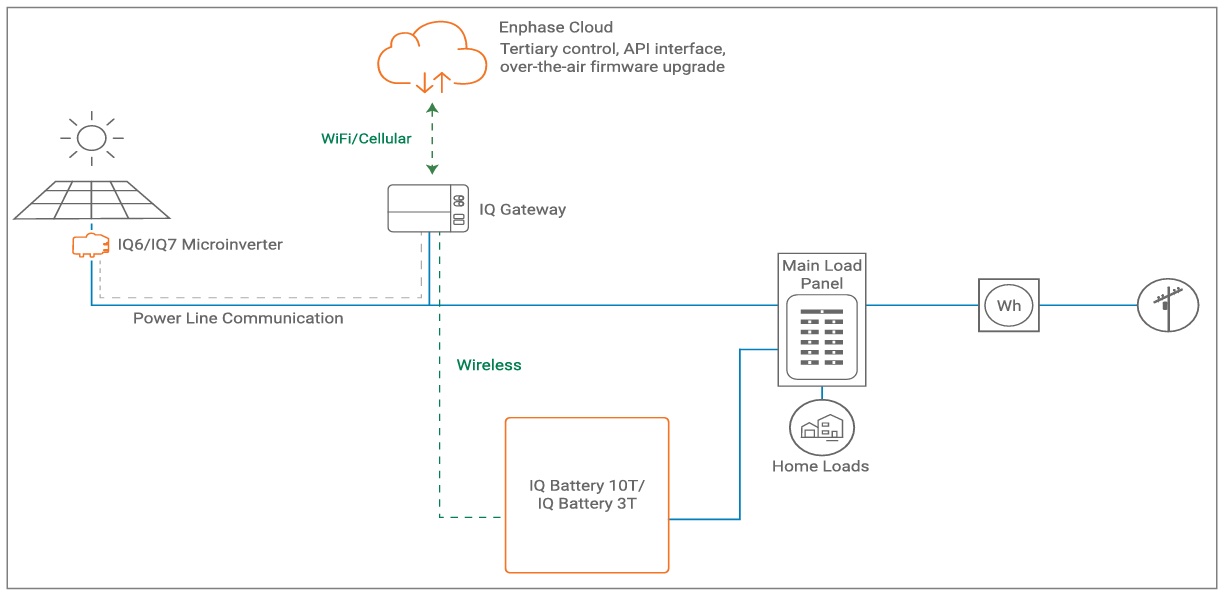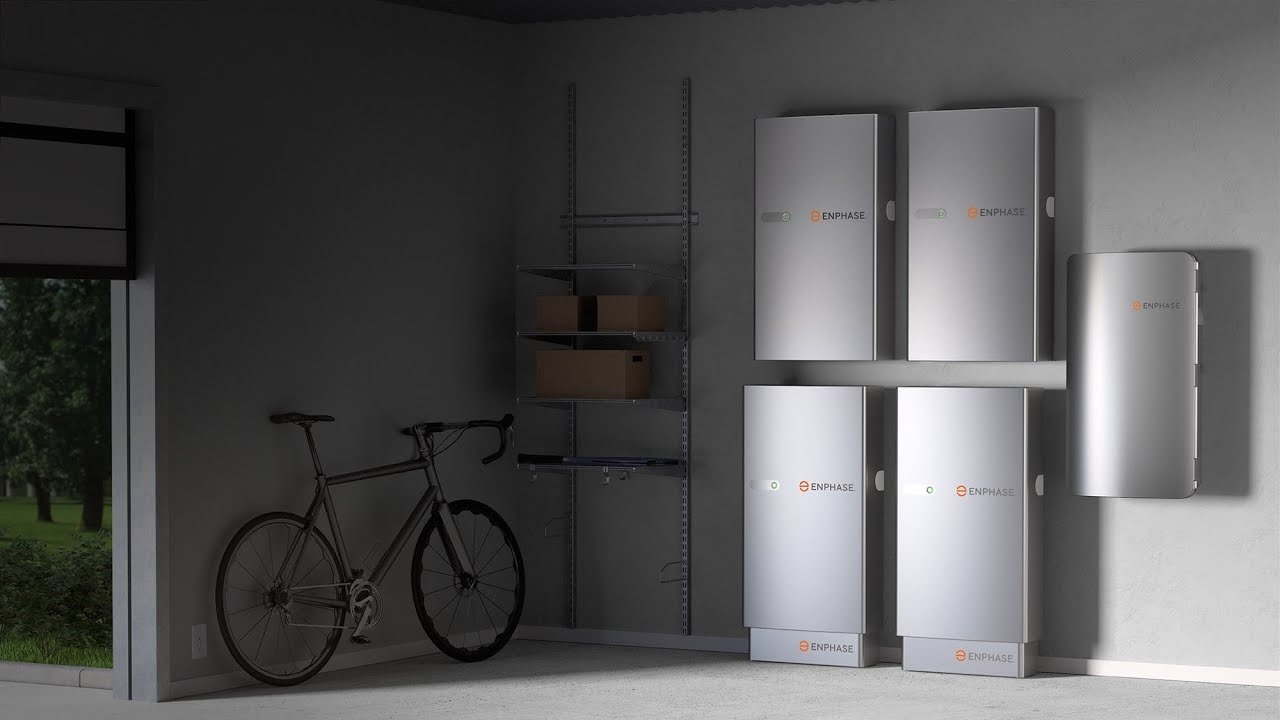Updated 8 months ago
Enphase battery review: Cost, specifications, and availability
Written by
Ben Zientara

Find out what solar-plus-storage costs in your area
Enphase is one of the most well-known and trusted brands in the solar industry. Its microinverters are used in roughly 40% of all new residential solar systems, and Enphase IQ batteries are becoming increasingly popular. Statistics from our 2025 Solar Industry Survey show that 74% of installers used Enphase batteries last year, and they landed the second place spot on our Best Solar Batteries of 2025 list.
The company’s current offerings include include the third-generation IQ 5P battery,, alongside its older siblings, the second-generation IQ 3T and IQ 10T. All of these batteries are fine additions to a home solar system, but the new IQ 5P is the star. With double the output of the previous generation, it wins our award as the best solar battery.
We recommend the Enphase IQ 5P battery to any homeowner, for both new and existing solar installations.
Key takeaways
-
Enphase products are very popular and trusted by more solar installers than any other brand.
-
The company currently offers two generations of its IQ batteries: the third-generation IQ 5P and the second-generation IQ 3T and 10T.
-
Enphase batteries use safe lithium iron phosphate battery cells, can be installed in multiple combinations of capacity and output, and come with industry-leading 15 year, 6,000 cycle warranties.
-
A complete system with two of the new IQ 5P batteries costs between $15,000 and $17,000, depending on your installer.
-
Swapping the battery to the older generation can save you $2,000 or so, but a complete system with one IQ 10T is limited to half the power output of the newer battery.
Enphase battery cost
Based on our industry research, an average-sized system that includes two Enphase IQ 5P batteries should cost around $15,000 before incentives. Enphase IQ batteries also qualify for the federal clean energy tax credit that can reduce that cost by 30%, as well as other state solar battery incentives.
If you choose to get the older Enphase IQ 10T battery (which offers the same energy storage capacity but half the power output) you'll save about $2,000 on the installation.
Enphase IQ batteries at a glance
Model | IQ 5P | IQ 3T | IQ 10T |
|---|---|---|---|
Capacity | 5 kWh | 3.36 kWh | 10.08 kWh |
Continuous power output | 3.84 kW | 1.28 kW | 3.84 kW |
Round-trip AC efficiency | 90% | 89% | 89% |
Dimensions | 38.6 in x 21.7 in x 7.4 in | 16.9 in x 30.5 in x 7.4 in | 50.5 in x 30.5 in x 7.4 in |
Weight | 174 lbs | 107.6 lbs | 316.5 lbs |
Warranty | 60% capacity @ 15 years or 6,000 cycles | 60% capacity @ 15 years or 6,000 cycles | 60% capacity @ 15 years or 6,000 cycles |
Components of the Enphase Energy System
When you buy an Enphase battery for home backup power, you’re actually getting more than just a battery; you’re getting an entire energy management system. There are three key pieces of equipment you’ll have installed:
One or more IQ Batteries store energy.
The IQ System Controller connects your home to the batteries, solar panels, and a backup generator (in some cases).
The IQ Combiner Box houses interconnection and communication equipment to make sure all the parts of your energy system can work together.
All of these components give you a complete system so you can easily store and use power when your home needs it the most. As with any solar battery, your solar panels will send excess solar energy produced during the day to the Enphase IQ system, which will be stored for later use.
Depending on your home, you may need to install a backup loads sub-panel, also called a critical or essential load panel. It’s a second electrical panel connected to your battery that powers the most important appliances and electrical loads that you want to run in your home if the power goes out. It typically adds $1,000 or $2,000 to your installation costs.
Enphase batteries without backup

Image source: Enphase
As shown in the above graphic, it is possible to get Enphase IQ batteries installed at your home for solar self-consumption without backup functionality. In this setup, you can skip installing the System Controller and IQ Combiner, and simply connect an IQ battery to your main load panel.
When properly installed with the Enphase IQ gateway for communication, the battery will be charged from excess solar energy and discharged to power the home during periods of time you can specify in the Enphase app. In the event of a grid outage, the battery will automatically shut off, and any energy stored inside will stay there until grid power is restored.
IQ Battery models
There are three models of Enphase batteries currently available from solar installers. The latest model is the third-generation IQ 5P, but Enphase still offers the second-generation IQ 3T and 10T. All of these batteries combine lithium iron phosphate (LFP) cells with battery management systems and Enphase’s microinverters to control the two-way flow of power.
There are some small but important differences between the two generations. The older batteries are still excellent energy storage devices, but they have somewhat lower output power and lower cost. The newer IQ 5P batteries come with twice the output power and therefore cost more.
Enphase IQ 5P batteries

Image source: Enphase
The third-generation Enphase IQ 5P holds 5 kWh of energy and has a continuous output of 3.84 kW, meaning 5P batteries can put out twice as much power per kWh of storage than the previous generation.
When installed with an Enphase IQ System Controller, Enphase IQ 5P batteries can be installed in any combination of up to 40 kWh, which results in a power output of up to 30.72 kW (128 amps at 240 volts).
Each IQ 5P comes with six of Enphase’s IQ8D-BAT microinverters, each of which can put out 640W of continuous power. Again, these microinverters are redundant—each one accounts for only 16.7% of the output of an IQ 5P, so the battery can continue to operate even if one or more microinverters has failed.
Enphase IQ 3T and 10T batteries

Image source: Enphase
Enphase IQ 3T and 10T batteries are the company’s second generation energy storage solutions. The 3T holds 3.36 kWh of energy in lithium iron phosphate (LFP) cells and has a continuous output of 1.28 kW. The 10T has triple the capacity and power output of the 3T to 10.08 kWh and 3.84 kW, respectively, because it’s really just three 3T batteries behind a nice cover.
On a kW-per-kWh of storage basis, the power output of Enphase T-series batteries is just half of what the comes with the IQ 5P. Like the 5P, T-series batteries can be installed in any combination of up to 40 kWh under a single system controller, but the power output of this setup equals just 15.36 kW (64 amps at 240 volts).
Each IQ 3T comes with four of Enphase’s IQ8X-BAT microinverters, which can each put out 320W of continuous power. The use of multiple microinverters provides redundancy—if one of them fails, the others can continue working while you wait for your solar installer to service the broken inverter.
Pros and cons of Enphase IQ batteries
The Enphase IQ battery is popular among installers for a reason. The ability to customize your system size and do it with a reliable brand is very compelling. But, as with anything, there are some things to remember when comparing the IQ Battery with other energy storage systems on the market.
Pros
Enphase is a trusted company and its products have an excellent history of performance and warranty coverage
Stackable modular design allows you to install just the right amount of storage and power output for your needs.
Industry-leading warranty terms
Enphase IQ batteries can be paired with gas-powered generators for extra backup protection.
Lithium iron phosphate chemistry is safer and longer lasting than alternatives some competitors use.
Various operating modes to meet your needs and a new operating mode on the 5P to get the most out of California’s new NEM 3.0 net billing.
Cons
Individual batteries have a lower power output than many competitors, so they might not be the first choice if you’re looking for a single-battery system.
Frequent firmware updates suggest that they are rapidly changing and debugging their software. This isn’t a huge red flag, but it just means they’re working out kinks in their battery products, and updating the firmware can be a nuisance.
The new IQ 5P cannot be installed alongside the older IQ 10 and IQ 3 models.
Enphase vs the competition
With the arrival of the IQ 5P, Enphase has earned the second place spot in our ranking of the best solar batteries on the market. The company was surpassed only by the Tesla Powerwall, which dethroned Enphase as #1 because of the low cost of the Powerwall 3 and its new, more flexible design.
Compared with the Tesla Powerwall, an Enphase system with three IQ 5P batteries exceeds the Powerwall’s output and holds more energy. That said, the 5P is significantly more expensive on a dollars-per kWh basis than what a Powerwall costs.
Compared with the Canadian Solar EP Cube, the Enphase IQ 5P battery compares more favorably on specs. A system with just 2 IQ 5P batteries edges out the EP Cube in terms of power output (although the EP Cube can be expanded up to 16.6 kWh under one inverter). Both companies offer modular expandability, but the EP Cube maintains an edge in efficiency, and costs nearly the same as a Powerwall on a dollars-per-kWh basis.
A system using Enphase IQ 5P batteries is actually less pricey than the Panasonic EverVolt battery, but the Panasonic solution offers more flexibility in sizing, smart controls, and methods to connect solar panels. EverVolt batteries also come with an excellent warranty backed by a 100 year-old electronics giant.
Final thoughts
As we mentioned above, the Enphase IQ system has several advantages over all the other batteries on the market. Enphase offers an industry-leading 15-year warranty, and the built-in modularity of microinverter technology means its batteries should operate more reliably over the long term.
It’s also important to stress that more solar installers choose Enphase batteries over any other brand. It may cost a bit more than competitors, but the Enphase IQ energy system has won a place near the top of anyone’s battery shortlist.
The way to find the best solar battery for you is by contacting a local solar company. Your solar installer can provide you with a quote for the battery system that checks all of your boxes. You can find trustworthy, local solar companies right here on SolarReviews to help you start on your journey toward energy independence!
Ben Zientara is a writer, researcher, and solar policy analyst who has written about the residential solar industry, the electric grid, and state utility policy since 2013. His early work included leading the team that produced the annual State Solar Power Rankings Report for the Solar Power Rocks website from 2015 to 2020. The rankings were utilized and referenced by a diverse mix of policymakers, advocacy groups, and media including The Center...
Learn more about Ben Zientara